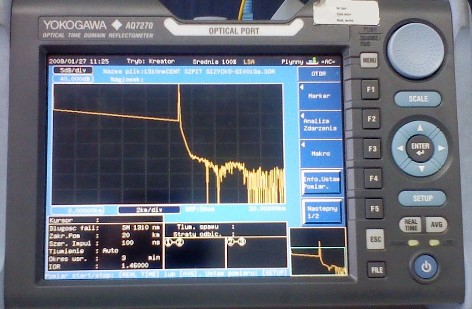OTDR and IL measurements
We’ll explore whether measurements at 1490 nm are necessary for PON systems. It’s important to note that there’s a significant difference between OTDR measurements and IL measurements. So, let’s delve into it!
OTDR measurements are used for analyzing optical fibers and networks. However, it can be challenging to perform OTDR testing on P2MP (Point-To-Multipoint) networks, like FTTH networks. With an OTDR instrument, you can locate events, identify reflection and attenuation at those events, and determine the total length of the optical path, total attenuation and reflections of the optical fiber, among other things.
According to the ITU-T standard (International Telecommunications Union-Telecommunications Sector) G.652, there’s no requirement for a specification at 1490 nm. Most fiber optic cable manufacturers offer fiber optic specifications at 1310 nm and 1550 nm. This suggests that the index refraction and backscatter coefficient for 1490 nm are unknown.
The attenuation of fusion splices and connector pairs remains constant across all wavelengths, including 1310 nm, 1490 nm, and 1550 nm, at 0.2 dB/km.
However, the attenuation on optical splitters varies depending on the wavelength. For instance, at the 1:32 optical splitter, the attenuation difference between 1490 nm and 1550 nm is approximately 0.3 dB.
Higher wavelengths like 1550 nm or 1625 nm (1650 nm) are crucial for macro bends. Conversely, 1490 nm has a lower attenuation rate than 1550 nm or 1625 nm, making it unnecessary to test for macro bends at 1490 nm.
Now, let’s discuss IL testing. The graph below displays fiber attenuation as a function of wavelength. It’s evident that the smallest difference in attenuation occurs between 1490 nm and 1550 nm.
The attenuation coefficient for G.652.C is 0.32 dB/km for 1310 nm, 0.21 dB/km for 1490 nm, and 0.19 dB/km for 1550 nm. This implies that the difference between 1490 nm and 1550 nm is only around 0.02 dB/km. Since PON networks are usually longer than 10 km, the IL difference between 1490 nm and 1550 nm could be as high as 0.2 to 0.3 dB/km.
Thus, OTDR and IL testing at 1490 nm are not necessary, given the minimal differences between 1490 nm and 1550 nm.
However, different wavelengths are used in PON systems, and each wavelength requires specialized measurements. For instance, the GPON system uses three wavelengths: 1490 nm for downstream, 1310 nm for upstream, and 1550 nm for video. Each wavelength has a distinct laser and requires measurement of optical power at a specific wavelength. The 1490 nm laser is a DFB laser, which is more expensive than the 1550 nm and 1310 nm lasers. Consequently, testing at 1490 nm is required for GPON systems and all other systems that use this wavelength.
